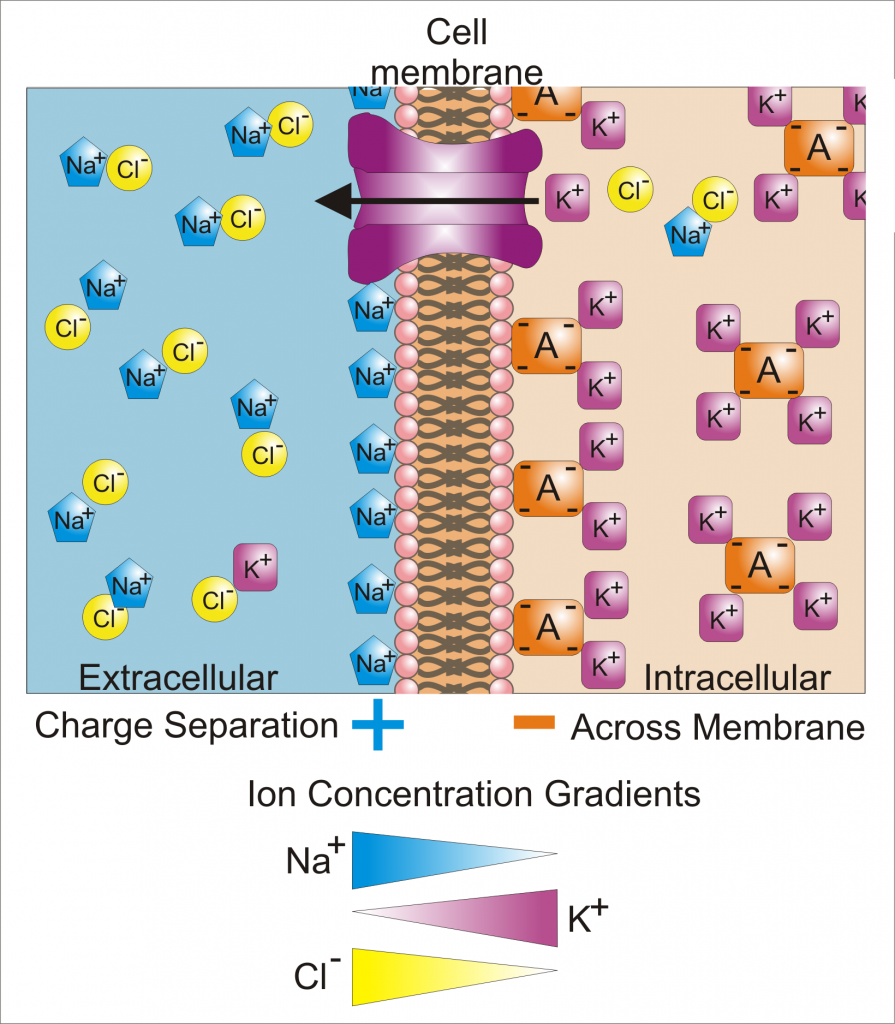
Physiology
Basic Cellular
The membrane threshold potential for a neurone, at which point an action potential can occur, is usually about:
Answer:
The threshold potential is generally around -55 mV.Resting Membrane Potential
Physiology / Basic Cellular / Action Potential
Last Updated: 30th August 2019
Electrical events in biological tissues are caused by the movement of ions across the membrane.
A membrane potential is a property of all cell membranes, but the ability to generate an action potential is only a property of excitable tissues.
The value of the membrane potential depends on the relative membrane permeability to the ions in the extracellular fluid (mainly Na+ and Cl-) and the intracellular fluid (mainly K+). In most neurons the resting potential has a value of approximately -70 mV. A cardiac myocyte has a resting potential of about -90 mV.
The resting membrane is more permeable to K+ and Cl- than to other ions. The cell contains negatively charged molecules (e.g. proteins) which cannot cross the membrane. This fixed negative charge attracts K+, leading to accumulation of K+ within the cell. However, the consequent increase in the K+ concentration gradient drives K+ back out of the cell. This means fewer K+ ions move into the cell than are required to achieve electrical neutrality with the fixed negative charges and the inside of the cell therefore remains negatively charged compared to the outside, causing a potential difference across the membrane.
These fixed anions also attract Na+ and the electrochemical gradient for Na+ is strongly inwards, however the resting membrane is relatively impermeable to Na+ and only a small amount of Na+ can leak in. A consequence of this setup is that if Na+ permeability were suddenly increased to more than that of K+, the membrane potential will depolarise; this is the basis of the action potential.

Resting Membrane Potential. (Image by Synaptidude, via Wikimedia Commons)
Report A Problem
Is there something wrong with this question? Let us know and we’ll fix it as soon as possible.
Loading Form...
- Biochemistry
- Blood Gases
- Haematology
| Biochemistry | Normal Value |
|---|---|
| Sodium | 135 – 145 mmol/l |
| Potassium | 3.0 – 4.5 mmol/l |
| Urea | 2.5 – 7.5 mmol/l |
| Glucose | 3.5 – 5.0 mmol/l |
| Creatinine | 35 – 135 μmol/l |
| Alanine Aminotransferase (ALT) | 5 – 35 U/l |
| Gamma-glutamyl Transferase (GGT) | < 65 U/l |
| Alkaline Phosphatase (ALP) | 30 – 135 U/l |
| Aspartate Aminotransferase (AST) | < 40 U/l |
| Total Protein | 60 – 80 g/l |
| Albumin | 35 – 50 g/l |
| Globulin | 2.4 – 3.5 g/dl |
| Amylase | < 70 U/l |
| Total Bilirubin | 3 – 17 μmol/l |
| Calcium | 2.1 – 2.5 mmol/l |
| Chloride | 95 – 105 mmol/l |
| Phosphate | 0.8 – 1.4 mmol/l |
| Haematology | Normal Value |
|---|---|
| Haemoglobin | 11.5 – 16.6 g/dl |
| White Blood Cells | 4.0 – 11.0 x 109/l |
| Platelets | 150 – 450 x 109/l |
| MCV | 80 – 96 fl |
| MCHC | 32 – 36 g/dl |
| Neutrophils | 2.0 – 7.5 x 109/l |
| Lymphocytes | 1.5 – 4.0 x 109/l |
| Monocytes | 0.3 – 1.0 x 109/l |
| Eosinophils | 0.1 – 0.5 x 109/l |
| Basophils | < 0.2 x 109/l |
| Reticulocytes | < 2% |
| Haematocrit | 0.35 – 0.49 |
| Red Cell Distribution Width | 11 – 15% |
| Blood Gases | Normal Value |
|---|---|
| pH | 7.35 – 7.45 |
| pO2 | 11 – 14 kPa |
| pCO2 | 4.5 – 6.0 kPa |
| Base Excess | -2 – +2 mmol/l |
| Bicarbonate | 24 – 30 mmol/l |
| Lactate | < 2 mmol/l |

